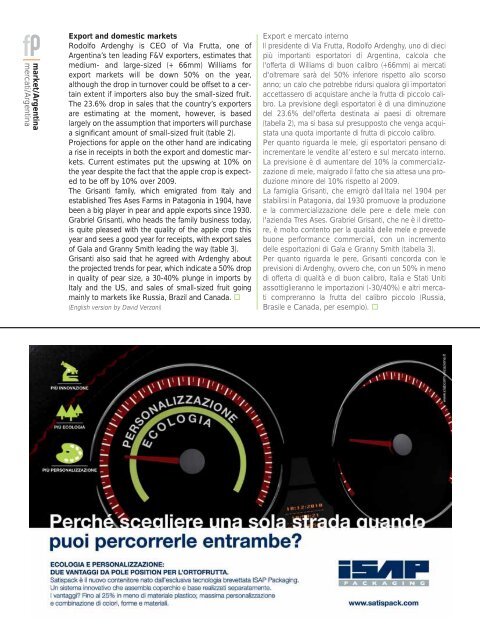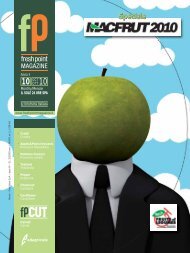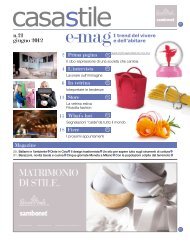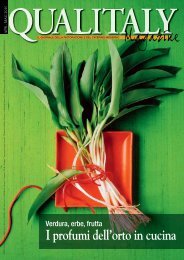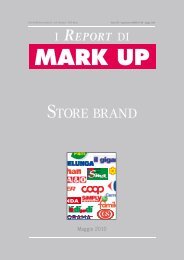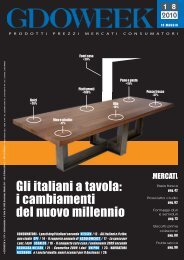Fresh Point Magazine - B2B24 - Il Sole 24 Ore
Fresh Point Magazine - B2B24 - Il Sole 24 Ore
Fresh Point Magazine - B2B24 - Il Sole 24 Ore
You also want an ePaper? Increase the reach of your titles
YUMPU automatically turns print PDFs into web optimized ePapers that Google loves.
market/Argentina<br />
mercati/Argentina<br />
Export and domestic markets<br />
Rodolfo Ardenghy is CEO of Via Frutta, one of<br />
Argentina’s ten leading F&V exporters, estimates that<br />
medium- and large-sized (+ 66mm) Williams for<br />
export markets will be down 50% on the year,<br />
although the drop in turnover could be offset to a certain<br />
extent if importers also buy the small-sized fruit.<br />
The 23.6% drop in sales that the country’s exporters<br />
are estimating at the moment, however, is based<br />
largely on the assumption that importers will purchase<br />
a significant amount of small-sized fruit (table 2).<br />
Projections for apple on the other hand are indicating<br />
a rise in receipts in both the export and domestic markets.<br />
Current estimates put the upswing at 10% on<br />
the year despite the fact that the apple crop is expected<br />
to be off by 10% over 2009.<br />
The Grisanti family, which emigrated from Italy and<br />
established Tres Ases Farms in Patagonia in 1904, have<br />
been a big player in pear and apple exports since 1930.<br />
Grabriel Grisanti, who heads the family business today,<br />
is quite pleased with the quality of the apple crop this<br />
year and sees a good year for receipts, with export sales<br />
of Gala and Granny Smith leading the way (table 3).<br />
Grisanti also said that he agreed with Ardenghy about<br />
the projected trends for pear, which indicate a 50% drop<br />
in quality of pear size, a 30-40% plunge in imports by<br />
Italy and the US, and sales of small-sized fruit going<br />
mainly to markets like Russia, Brazil and Canada.<br />
(English version by David Verzoni)<br />
Export e mercato interno<br />
<strong>Il</strong> presidente di Via Frutta, Rodolfo Ardenghy, uno di dieci<br />
più importanti esportatori di Argentina, calcola che<br />
l'offerta di Williams di buon calibro (+66mm) ai mercati<br />
d'oltremare sarà del 50% inferiore rispetto allo scorso<br />
anno; un calo che potrebbe ridursi qualora gli importatori<br />
accettassero di acquistare anche la frutta di piccolo calibro.<br />
La previsione degli esportatori è di una diminuzione<br />
del 23.6% dell'offerta destinata ai paesi di oltremare<br />
(tabella 2), ma si basa sul presupposto che venga acquistata<br />
una quota importante di frutta di piccolo calibro.<br />
Per quanto riguarda le mele, gli esportatori pensano di<br />
incrementare le vendite all’estero e sul mercato interno.<br />
La previsione è di aumentare del 10% la commercializzazione<br />
di mele, malgrado il fatto che sia attesa una produzione<br />
minore del 10% rispetto al 2009.<br />
La famiglia Grisanti, che emigrò dall´Italia nel 1904 per<br />
stabilirsi in Patagonia, dal 1930 promuove la produzione<br />
e la commercializzazione delle pere e delle mele con<br />
l'azienda Tres Ases. Grabriel Grisanti, che ne è il direttore,<br />
è molto contento per la qualità delle mele e prevede<br />
buone performance commerciali, con un incremento<br />
delle esportazioni di Gala e Granny Smith (tabella 3).<br />
Per quanto riguarda le pere, Grisanti concorda con le<br />
previsioni di Ardenghy, ovvero che, con un 50% in meno<br />
di offerta di qualità e di buon calibro, Italia e Stati Uniti<br />
assottiglieranno le importazioni (-30/40%) e altri mercati<br />
compreranno la frutta del calibro piccolo (Russia,<br />
Brasile e Canada, per esempio).


